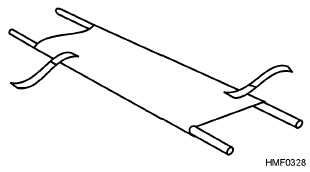Stretchers
The military uses a number of standard stretchers.
The following discussion will familiarize you with the
most common types.
When using a stretcher, you
should consider a few general rules:
Use standard stretchers when available, but be
ready to improvise safe alternatives.
When possible, bring the stretcher to the
casualty.
Always fasten the victim securely to the
stretcher.
Always move the victim FEET FIRST so the
rear bearer can watch for signs of breathing
difficulty.
STOKES STRETCHER.—The Navy service
litter most commonly used for transporting sick or
injured persons is called the Stokes stretcher.
As
shown in figure 3–27, the Stokes stretcher is
essentially a wire basket supported by iron rods. Even
if the stretcher is tipped or turned, the casualty can be
held securely in place, making the Stokes adaptable to
a variety of uses. This stretcher is particularly valuable
for transferring injured persons to and from boats. As
mentioned before, it can also be used with flotation
devices to rescue injured survivors from the water. It is
also used for direct ship-to-ship transfer of injured
persons. Fifteen-foot handling lines are attached to
each end for shipboard use in moving the victim.
The Stokes stretcher should be padded with three
blankets: two of them should be placed lengthwise (so
that one will be under each of the casualty’s legs), and
the third should be folded in half and placed in the
upper part of the stretcher to protect the head and
shoulders. The casualty should be lowered gently into
the stretcher and made as comfortable as possible. The
feet must be fastened to the end of the stretcher so that
the casualty will not slide down. Another blanket (or
more, if necessary) should be used to cover the
casualty. The casualty must be fastened to the stretcher
by means of straps that go over the chest, hips, and
knees. Note that the straps go OVER the blanket or
other covering, thus holding it in place.
ARMY LITTER.—The Army litter, shown in
figure 3–28, is a collapsible stretcher made of canvas
and supported by wooden or aluminum poles. It is very
useful for transporting battle casualties in the field.
However, it is sometimes difficult to fasten the
casualty onto the Army litter, and for this reason its use
is somewhat limited aboard ship. The litter legs keep
the patient off the ground.
The legs fit into the
restraining tracks of a jeep or field ambulance to hold
the litter in place during transport.
MILLER (FULL BODY) BOARD.¾The Miller
Board (fig 3-29) is constructed of an outer plastic shell
with an injected foam core of polyurethane foam. It is
impervious to chemicals and the elements and can be
used in virtually every confined-space rescue and
vertical extrication. The Miller Board provides for full
body immobilization through a harness system,
including a hood and two-point contact for the head
(forehead and chin) to stabilize the head and cervical
spine. The board’s narrow design allows passage
through hatches and crowded passageways. It fits
3-18
Figure 3–27.—Stokes stretcher.
Figure 3–28.—Opening an Army litter.



